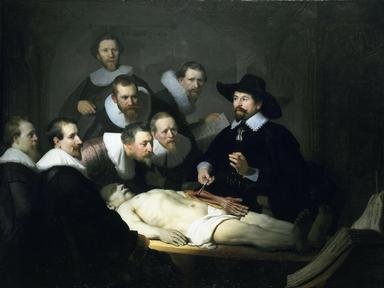Quiz Answer Key and Fun Facts
1. This 1632 oil painting by Rembrandt is famous for its portrayal of a well-respected surgeon named Nicolaes Tulp. On a table lies a corpse with several men gathered around. It is a dramatic example of mise-en-scene as well as an astonishing portrait all wrapped in one. What was the good Dr. Tulp doing in the painting?
2. Rembrandt painted over 40 self-portraits, with "Self-Portrait with Beret and Turned-Up Collar" being perhaps the most famous. Rembrandt used the contrast of dark and light colors to make his face really pop, but he was said to have also applied the paint thickly to the canvas of this self-portrait, creating an additional physical contrast. Which artistic term did Rembrandt's pupil, Samuel van Hoogstraten, use to describe this second kind of contrast?
3. "The Night Watch" (1642), officially titled "Militia Company of District II under the Command of Captain Frans Banninck Cocq" is famous for many things, but many people are surprised to learn that the actual painting itself stands approximately three times taller than the average person. It is enormous, so enormous that which of these events happened to it when it was moved to the Amsterdam Town Hall in 1715?
4. This painting, finished in 1669, earned the nickname of "The Jewish Bride" in the 19th century when a Dutch art collector expressed that he believed it depicted a Jewish father giving a necklace to his daughter on her wedding day. The Rijksmuseum in Amsterdam states, however, that the painting actually most likely depicts which married Biblical couple?
5. During the period 1990-2000, this Rembrandt painting titled "The Storm on the Sea of Galilee" (1633) held the record for having the second-most visitors at the Louvre in Paris, France, right after the "Mona Lisa".
6. Rembrandt's commissioned paintings are often what most people think of when they hear his name. The Dutch portraits with the telling clothing are instantly recognizable. Yet, Amsterdam's elite called on him less and less later in his life. Pictured here, which painting completed in 1662 proved that Rembrandt was still a master even as an old man?
7. Painters often employ models to help them fashion faces and bodies for historical or mythological subjects, and Rembrandt's "DanaŽ" (1636) is no exception.
True or false: Rembrandt originally used his wife as the model for the painting, but he went back later and replaced the face with that of his mistress.
8. "Belshazzar's Feast" (1635) represents a slight departure in style by Rembrandt, deploying a color palette richer than was typical from the artist. Supposedly written by a divine hand in the biblical story of Belshazzar, what language did Rembrandt use in this painting (in a purposefully incorrect manner)?
9. The biblical parable where a wasteful yet penitent son comes home and is forgiven by his father provides a popular backdrop for many painters. Pictured is what many consider Rembrandt's best work, "The Return of the Prodigal Son" (1669), which was painted near the end of his life. However, another painting with a similar title (done early on in his career in 1637) shows Rembrandt and his wife Saskia in quite a different light. What is the title of this other painting?
10. This famous self-portrait has been the subject of much speculation for its depiction of not only the artist but also what can be seen in the background. It is titled "Self-Portrait with Two _______" what?
Source: Author
trident
This quiz was reviewed by FunTrivia editor
looney_tunes before going online.
Any errors found in FunTrivia content are routinely corrected through our feedback system.
